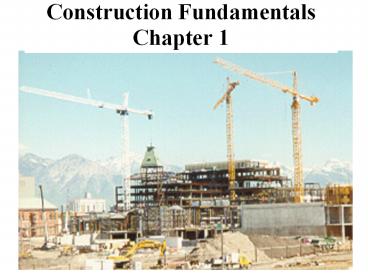Construction Fundamentals Chapter 1 PowerPoint PPT Presentation
1 / 34
Title: Construction Fundamentals Chapter 1
1
Construction FundamentalsChapter 1
2
Chapter 1 - Historical Perspective
- Architect comes from a Greek word meaning
- chief artifice,
- masterbuilder,
- director of works.
3
Chapter 1 - Historical Perspective
- Architect
- Romans used the Latin form architectus - the
architects responsibilities was to design and
superintend the construction of the work.
4
Chapter 1 - Historical Perspective
- Contractor
- comes from the legal agreement or contract that
is negotiated and executed between the owner and
the builder - General Contractor
- As there can be many builders involved on a
project a hierarchy of responsibility and
authority needs to be established to insure
proper coordination of the various efforts
5
Construction
- Engineering and construction are a unique
combination of specific need and specific design
in a process that yields an engineered work. - Civilizations are built by construction efforts.
6
Construction
- Civil Engineers
- Military Engineers
7
Engineering Education
- LEcole Polytechnique
- authorized in 1795 by Napoleon
- U. S. Military Academy, West Point
- organized by President Thomas Jefferson 1802
8
Canals
- Man-made canals were a major factor in the
development of early civilization - Barge Canals
- Chesapeake and Ohio (1828-1850)
- Ship Canals
- Suez (1869)
- Panama (1914)
9
Rail Roads
10
Rail Roads
- The railroads were the engine of growth and
expansion to the West - By 1840 there were nearly three thousand miles of
track in the United States
11
Rail Roads
- Congress passed the Pacific Railroad Act in 1862.
- The act authorized the Central Pacific and Union
Pacific Companies to build a transcontinental
rail line along the 42nd parallel - May 10, 1869 Golden spike driven home
12
(No Transcript)
13
Golden Spike
The web site to learn more about this historic
engineering accomplishment. http//www.nps.gov/go
sp/ Additional reading C.P.R.R. The Central
Pacific Railroad - Charles Nordoff, Outbooks,
Golden, CO 1976 (originally written 1892).
Empire Express Building the First
Transcontinental Railroad - David Haward
Bain, Penguin Putnam, New York, NY. 1999.
14
Golden Spike
Additional reading History of the Union Pacific
Railway - Henry K. White, University of Chicago
Press, Chicago, IL. 1895. Nothing Like It In The
World- The Men Who Built The Transcontinental
Railroad 1863-1869 - Stephen E. Ambrose, Simon
Schuster, New York, NY. 2000. Rails From the
West a Biography of Theodore D. Judah - Helen
Hinkley, Golden West Books, San Marino, CA 1969.
Ten Mile Day And The Building of the
Transcontinental Railroad Mary Ann Fraser Henry
Holt and Company, New York, NY 1993.
15
Industrial Buildings
- Buildings of the mid-19th century tended to be
narrow enclosures with load-bearing walls
16
Industrial Buildings
- Between 1874 and 1904 many advances made
- Construction methods and materials
- fire protection
- steel trusses framing
17
Industrial Buildings
- 1920s industrial buildings were being
constructed with skeleton framing and curtain
walls
18
Industrial Buildings
- Concrete building systems have also been
developed. - cast-in-place
- tilt-up
- precast
19
Highways
- Appian Way
- Dwight D. Eisenhower Interstate Highway System
(1956)
20
I-17/I-10 Phoenix AZ
21
Airports
- Phoenix Sky Harbor International Airport,
Phoenix, AZ
22
Airports
- Construction at Dallas/Ft. Worth International
Airport, 2002
23
Skyscrapers
- 1800s few buildings were more than 100 ft high
- Walls were load bearing (up to 5 feet thick)
- Doors window penetrations were kept to a minimum
24
Skyscrapers
25
Skyscrapers
26
Skyscrapers
- Four engineering innovations had to come together
before the height of building would rise to a
level where they would be called skyscrapers. - Safe elevators
- Steel Framing
- Fireproofing
- Caisson method of foundation construction
27
(No Transcript)
28
(No Transcript)
29
Construction Industry
- Egyptians
- Greeks
- Romans
- corvee - Latin corrogare, to summon together
- Collegia
30
Construction Industry
- Romans Collegia
- Membership for skilled craftsmen became mandatory
- Workers had to follow the same trade for life and
their descendants after them - Wages were fixed
- Craftsmen could be transferred to any location as
directed by the state
31
Master Builders
- Reported to the owner
- Responsible for both
- Design and
- Construction
32
Master Builders
- Used the principle of proportional geometry to
construct complicated designs with a minimum of
equipment
33
Contractors
- From the legal agreement or contract that is
negotiated and executed between the owner and the
builder - General contractor (GC)
- Specialty or trade contractors
- Electrical
- Plumbing
- Heating and air conditioning (HVAC)
34
Assignment
- Due next class
- What is the largest or most famous _____ in your
state? And why!! - Canal
- Road
- Bridge
- Skyscraper
- Airport

